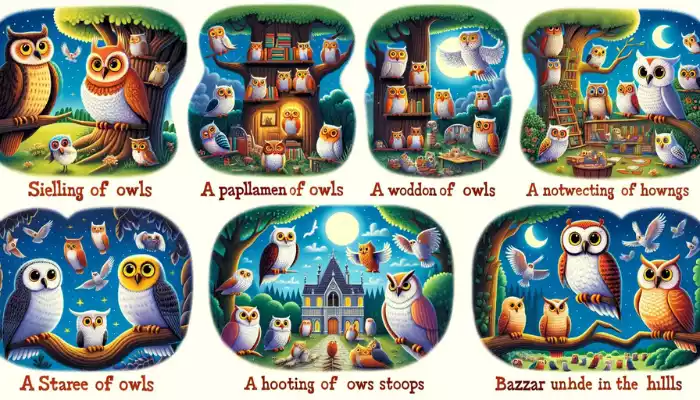The nocturnal silhouette of an owl, perched silently on a branch, has captivated humankind for millennia. It’s an image steeped in symbolism, mystery, and perhaps a touch of the uncanny. We observe these majestic creatures in their solitary splendor, but what happens when they gather? What lexicon do we employ to describe a congregation of these feathered denizens of the night? The answer, as with many collective nouns, is multifaceted and evocative.
The most widely recognized collective noun for owls is a “parliament.” This term, resonant with connotations of wisdom, deliberation, and solemn pronouncements, perfectly encapsulates the perceived sagacity associated with these birds. The very act of assigning “parliament” to a group of owls elevates them beyond mere creatures of the wild; it imbues them with an aura of venerable authority.
However, the “parliament” is not the sole descriptor. A less common, yet equally intriguing, collective noun is a “hoot” of owls. This alternative term, far more onomatopoeic than “parliament,” directly references the characteristic vocalization of these birds. The “hoot,” a quintessential sound of the night, immediately conjures images of owls communicating across vast distances, their calls echoing through forests and fields. It’s a more visceral and immediate descriptor, connecting us directly to the aural experience of encountering these creatures.
Beyond “parliament” and “hoot,” other, even more obscure, collective nouns for owls exist, adding further layers of complexity and nuance to our understanding of these social gatherings. These include “study” and “wisdom,” both reinforcing the owl’s longstanding association with knowledge and learning. The term “study,” in particular, suggests a group engaged in observation and analysis, a fitting metaphor for the owl’s keen senses and hunting prowess.
But why so many terms? The multiplicity of collective nouns for owls reflects not only the rich tapestry of language but also the diverse ways in which we perceive and interact with these animals. “Parliament” speaks to our reverence for their perceived wisdom, while “hoot” captures the essence of their nocturnal communication. Other terms, like “study,” delve deeper into their behavioral characteristics.
The selection of a particular collective noun can be a deliberate act, influenced by the context, the intended meaning, and even the emotional tone one wishes to convey. Describing a group of owls observed during a scientific expedition might lend itself more readily to the term “study,” while recounting a folklore tale of nocturnal gatherings might favor “parliament.” The choice, therefore, becomes an exercise in linguistic artistry.
The social behavior of owls themselves contributes to the appropriateness of these collective nouns. While often portrayed as solitary hunters, many owl species do exhibit social tendencies, particularly during breeding season. Pairs may establish long-term bonds, and young owls may remain with their parents for extended periods, forming small family groups. The formation of these social units justifies the use of collective nouns, highlighting the importance of recognizing owls as more than just solitary predators.
Moreover, the visual impact of seeing a group of owls cannot be overlooked. Imagine witnessing a cluster of snowy owls perched upon snow-dusted branches, their white plumage blending seamlessly with the winter landscape. Or envision a gathering of barn owls in an old, abandoned barn, their heart-shaped faces illuminated by the faint moonlight. Such sights are rare and remarkable, solidifying the image of owls as creatures worthy of special recognition and descriptive language.
The act of assigning a collective noun is, in itself, an act of categorization and understanding. It allows us to grasp the concept of a group, to visualize its form and function. In the case of owls, the multiplicity of collective nouns underscores the multifaceted nature of these birds, acknowledging their ecological importance, their symbolic resonance, and their enduring fascination.
Therefore, the next time you encounter the term “parliament,” “hoot,” “study,” or any other collective noun for owls, take a moment to appreciate the rich linguistic heritage that informs our understanding of these magnificent creatures. Remember that these terms are not merely arbitrary labels; they are reflections of our deep-seated fascination with the natural world and our ongoing quest to understand the intricate relationships between humans and animals. They are windows into the soul of language, revealing the power of words to shape our perceptions and deepen our appreciation for the wonders of nature. Consider the nuances, the subtle differences in meaning, and the evocative power of each term. Choose wisely, and let your words reflect the profound respect and admiration that these “wise old birds” deserve.
